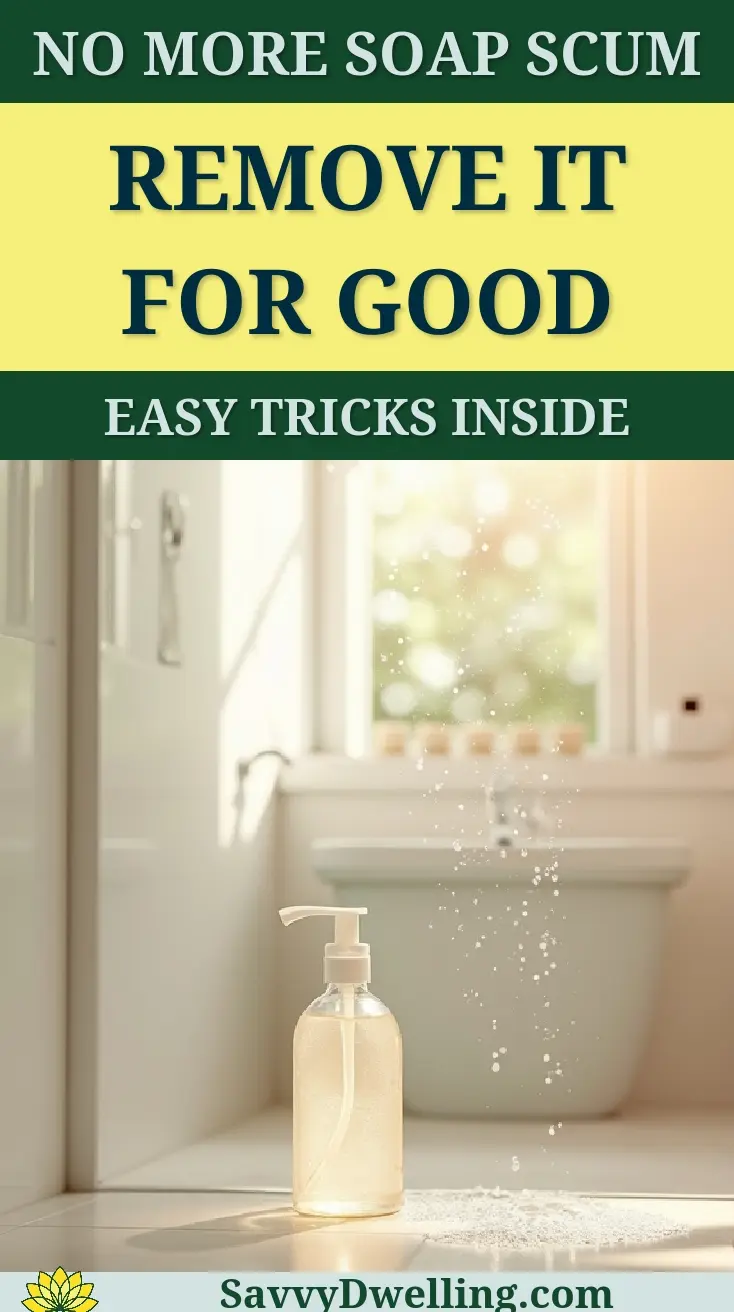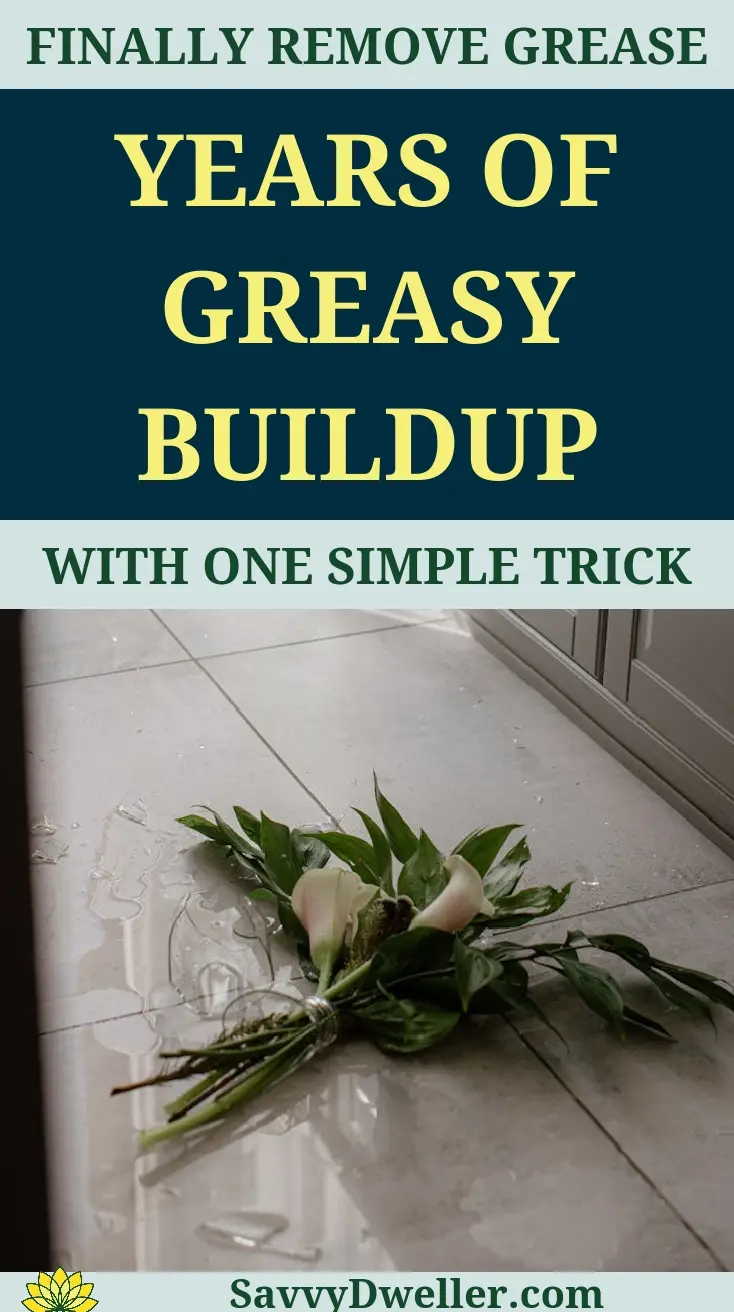How to Get Rid Of Hard Water Stains on Faucets and Shower Heads: 7 Proven Methods That Actually Work
Staring at those stubborn white, chalky spots covering your once-shiny faucets and shower heads? Those crusty mineral deposits make even the cleanest bathroom look neglected, and scrubbing with regular cleaners only seems to spread them around instead of removing them.
We’ve tested dozens of methods to find the ones that truly dissolve hard water stains without damaging your fixtures. This guide breaks down seven proven techniques—from simple pantry ingredients to professional-grade solutions—that will restore your bathroom hardware to its original sparkle, plus the science-backed strategies to keep those stains from returning.
Contents
- At a Glance: The Best Solutions
- 1. The White Vinegar Soak Method
- 2. The Baking Soda Paste Scrub
- 3. The Lemon and Salt Power Combo
- 4. The CLR (Calcium, Lime &Amp; Rust) Commercial Solution
- 5. The Bar Keepers Friend Method
- 6. The Coca-cola Cleaning Hack
- 7. The Professional-grade Descaling Method
- Fixture-specific Cleaning Techniques
- The Science Made Simple: Why Hard Water Stains Happen
- Common Mistakes to Avoid When Removing Hard Water Stains
- 5 Habits to Keep Hard Water Stains From Coming Back
- Frequently Asked Questions
- Final Words
At a Glance: The Best Solutions
If you’ve been staring at those stubborn white spots on your faucets and shower heads, you’re not alone. Hard water stains are one of the most persistent bathroom cleaning challenges homeowners face.
The good news is that you already have most of what you need to tackle these mineral deposits right in your kitchen pantry. From white vinegar to baking soda, simple household ingredients can dissolve those chalky buildup layers effectively.
Each method below targets hard water stains differently. Some use acid to dissolve mineral deposits, while others rely on gentle abrasion or commercial formulations designed specifically for calcium and lime removal.
The key to success isn’t just choosing the right method—it’s about matching the technique to your specific fixture type and stain severity. Chrome fixtures respond differently than brushed nickel, and light surface stains require less aggressive treatment than thick, years-old buildup.
Before diving into any cleaning method, always test your chosen solution on a hidden area of your fixture first. This simple step prevents potential damage to special finishes or coatings that could cost hundreds to replace.
Most of these solutions work within 15-30 minutes, though heavily stained fixtures may need multiple treatments or overnight soaking for complete removal. The best part? Once you know how to remove hard water stains effectively, maintaining clean fixtures becomes much easier.
1. The White Vinegar Soak Method
How It Works
White vinegar contains acetic acid that naturally dissolves calcium and magnesium buildup on fixtures. The acid breaks down mineral deposits without harsh chemicals, making it safe for most finishes.
This method works best when you give the vinegar time to penetrate stubborn deposits. The longer contact time allows the acid to soften even thick, chalky residue that’s been building up for months.
What You’ll Need
- White distilled vinegar (5% acidity)
- Plastic bags or ziplock bags
- Rubber bands or hair ties
- Old toothbrush or soft-bristled brush
- Microfiber cloth
- Small bowl for soaking removable parts
Step-by-step Instructions
For Faucets
- Fill a plastic bag with undiluted white vinegar until it’s about halfway full.
- Submerge the faucet aerator completely in the vinegar by securing the bag around the faucet with a rubber band.
- Let the vinegar work for 4-6 hours or overnight for heavily stained fixtures.
- Remove the bag and scrub gently with an old toothbrush to loosen remaining deposits.
- Run water through the faucet for 30 seconds to flush out loosened minerals.
- Wipe dry with a microfiber cloth to prevent new water spots from forming.
For Shower Heads
- Remove the shower head if possible by unscrewing it counterclockwise with pliers wrapped in a towel.
- Submerge the entire shower head in a bowl filled with white vinegar for 8-12 hours.
- For fixed shower heads, fill a plastic bag with vinegar and secure it around the shower head with rubber bands.
- After soaking, use a toothbrush to scrub spray holes and crevices where minerals accumulate.
- Run hot water through the shower head for 2-3 minutes to clear out dissolved deposits.
- Reattach the shower head and test all spray settings to ensure proper water flow.
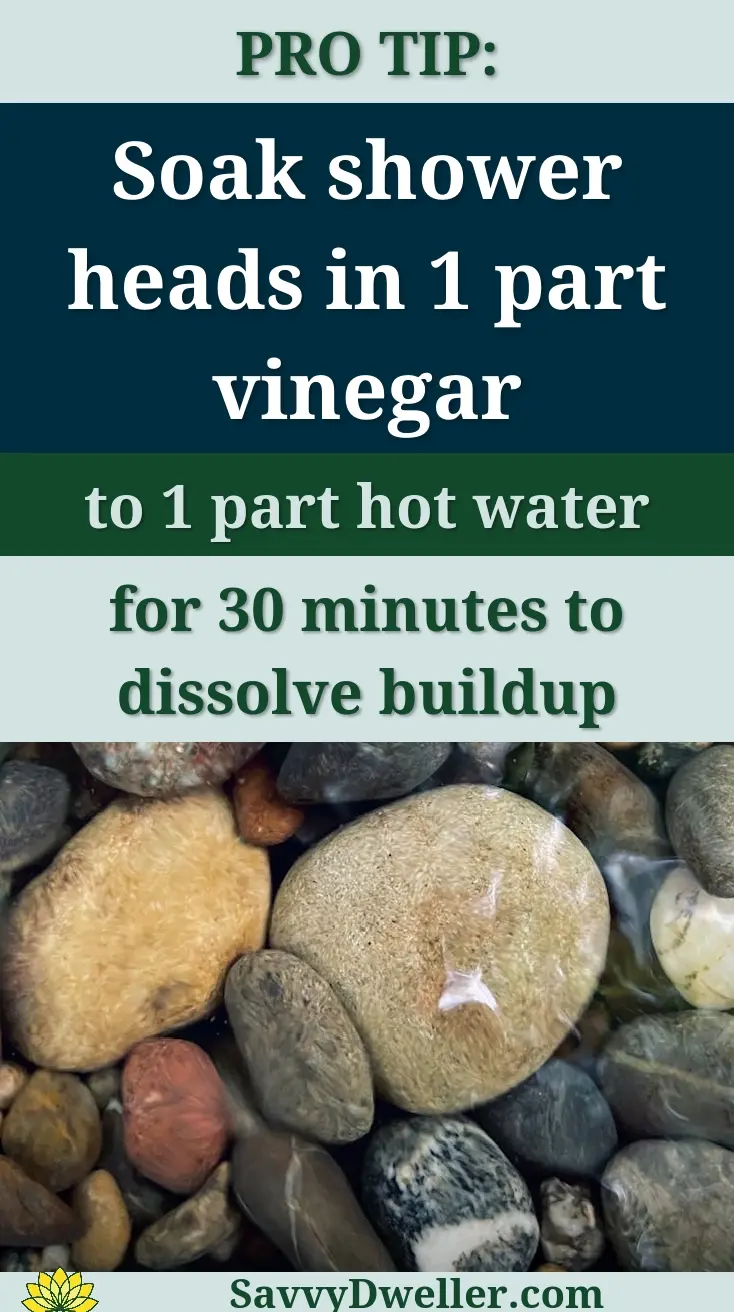
2. The Baking Soda Paste Scrub
How It Works
Baking soda acts as a mild abrasive that scrubs away mineral deposits without scratching fixture surfaces. Its alkaline properties help neutralize acidic buildup while providing gentle scrubbing action. It’s also a versatile cleaning agent that can tackle a wide variety of household stains and messes. For instance, there are 53 clever ways to clean almost everything with baking soda, from freshening carpets to unclogging drains.
This method excels at removing stubborn stains that vinegar alone can’t budge. The paste consistency allows you to target specific problem areas with precision.
What You’ll Need
- Baking soda (3-4 tablespoons)
- Water (1-2 tablespoons)
- Small mixing bowl
- Old toothbrush or soft scrub brush
- Microfiber cloth
- Rubber gloves (optional)
Step-by-step Instructions
- Mix baking soda with water in a small bowl until you create a thick, spreadable paste.
- Apply the paste generously to stained areas, focusing on visible mineral buildup.
- Let the paste sit for 15-20 minutes to soften the deposits.
- Scrub in circular motions with a toothbrush, paying extra attention to crevices and textured surfaces.
- Rinse thoroughly with warm water, ensuring all baking soda residue is removed.
- Dry completely with a microfiber cloth to reveal the clean surface underneath.
- Repeat the process for extremely stubborn stains that don’t come off in the first round.
Also See: Removing Soap Scum From Shower Doors for Good
3. The Lemon and Salt Power Combo
How It Works
Fresh lemon juice contains citric acid that dissolves hard water minerals, while salt provides gentle abrasive action. This natural combination cuts through calcium buildup while leaving fixtures with a fresh, clean scent.
The citric acid in lemons is actually more concentrated than vinegar, making this method particularly effective on thick, chalky deposits. Salt enhances the scrubbing power without being too harsh on delicate finishes. A quick and easy way to utilize this is by cleaning your microwave with lemon in just two minutes. The steam generated from the lemon helps loosen stubborn stains and eliminates odors, making it a simple yet effective cleaning hack.
What You’ll Need
- Fresh lemons (2-3 lemons)
- Coarse salt (2-3 tablespoons)
- Small plate or cutting board
- Sharp knife
- Soft cloth or sponge
- Warm water for rinsing
Step-by-step Instructions
- Cut fresh lemons in half and squeeze out most of the juice into a small bowl.
- Dip the cut lemon directly into coarse salt, coating the flesh completely.
- Rub the salt-covered lemon directly onto hard water stains using firm, circular motions.
- Focus extra attention on heavily stained areas where minerals have built up over time.
- Let the lemon juice and salt mixture sit on the surface for 10-15 minutes.
- Scrub again with the lemon half, then rinse thoroughly with warm water.
- Wipe dry with a soft cloth to prevent new water spots from forming immediately.
- For shower heads, squeeze fresh lemon juice into spray holes and let it work for 20 minutes before rinsing.
4. The CLR (Calcium, Lime &Amp; Rust) Commercial Solution
How It Works
CLR uses a powerful combination of acids specifically formulated to dissolve mineral deposits without harming most fixture finishes. This commercial cleaner targets the molecular bonds in calcium and lime buildup, making it exceptionally effective for stubborn shower head hard water stains.
The formula works faster than natural alternatives because it contains higher concentrations of active ingredients. You’ll see results in minutes rather than hours, making it perfect for heavily stained fixtures that haven’t responded to gentler methods.
What You’ll Need
- CLR cleaner (original formula)
- Plastic bags or containers for soaking
- Rubber bands or zip ties
- Non-abrasive cloth or sponge
- Rubber gloves
- Eye protection
- Old toothbrush for detail work
Step-by-step Instructions
- Put on your rubber gloves and eye protection before handling CLR.
- For shower heads, fill a plastic bag with undiluted CLR and secure it around the fixture with rubber bands.
- For faucets, apply CLR directly to stained areas using a cloth or spray bottle.
- Allow the cleaner to work for 2-5 minutes (never exceed the time recommended on the label).
- Use an old toothbrush to gently scrub textured areas where minerals tend to accumulate.
- Rinse thoroughly with cold water to remove all cleaner residue.
- Wipe dry immediately with a clean cloth to prevent new water spots from forming.
Safety Precautions
Never mix CLR with other cleaning products, especially bleach or ammonia-based cleaners, as this can create dangerous chemical reactions. Always test on a small, hidden area first to ensure compatibility with your fixture’s finish.
Ensure adequate ventilation while using CLR, and never leave it on surfaces longer than recommended. The powerful acids can damage certain finishes if left too long, particularly on brass or bronze fixtures.
5. The Bar Keepers Friend Method
How It Works
Bar Keepers Friend contains oxalic acid, a naturally occurring compound that excels at removing mineral deposits and water stains. This powder cleaner creates a gentle abrasive action that scrubs away buildup while the acid dissolves stubborn calcium deposits.
Unlike harsher commercial cleaners, Bar Keepers Friend is safe for most metal finishes and won’t cause pitting or discoloration. It’s particularly effective on stainless steel and chrome fixtures.
What You’ll Need
- Bar Keepers Friend powder
- Small bowl for mixing
- Water
- Soft-bristled brush or cloth
- Rubber gloves
- Clean rags for wiping
Step-by-step Instructions
- Mix Bar Keepers Friend powder with just enough water to create a thick paste consistency.
- Apply the paste directly to hard water stains on faucets and shower heads using your fingers or a cloth.
- Let the paste sit for 1-2 minutes to allow the oxalic acid to work on mineral deposits.
- Gently scrub with a soft-bristled brush, focusing on heavily stained areas.
- For shower heads, work the paste into crevices and around spray nozzles where calcium buildup is common.
- Rinse thoroughly with warm water, ensuring all powder residue is removed.
- Buff dry with a clean cloth to reveal the restored shine.
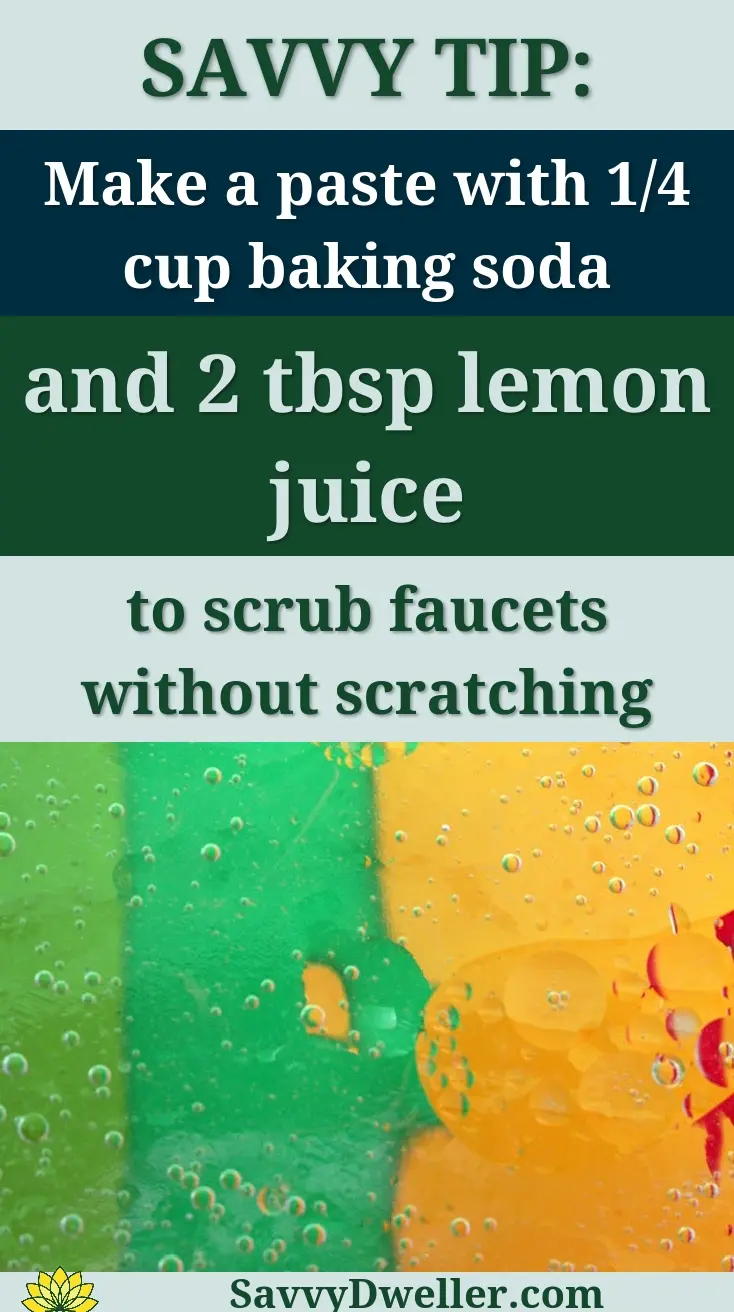
6. The Coca-cola Cleaning Hack
How It Works
Coca-Cola contains phosphoric acid, the same ingredient found in many commercial rust removers and descalers. The carbonation helps the acid penetrate mineral deposits while the syrup provides a coating that extends contact time with stubborn stains.
While this method might sound unconventional, the phosphoric acid content makes Coke surprisingly effective at dissolving calcium and lime buildup. It’s gentler than commercial cleaners and won’t damage delicate finishes.
What You’ll Need
- Regular Coca-Cola (not diet versions)
- Plastic bags for soaking
- Rubber bands or zip ties
- Soft cloth or sponge
- Old toothbrush
- Clean water for rinsing
Step-by-step Instructions
- Pour room-temperature Coca-Cola into a plastic bag, ensuring you have enough to fully submerge the shower head.
- Secure the bag around your shower head with rubber bands, making sure the fixture is completely covered.
- For faucets, soak a cloth in Coke and wrap it around the aerator and spout areas.
- Allow the Coke to work for 1-2 hours, giving the phosphoric acid time to dissolve mineral deposits.
- Remove the bag and scrub gently with an old toothbrush to remove loosened buildup.
- Rinse thoroughly with warm water to remove all sticky residue.
- Wipe dry with a clean cloth and polish if needed to restore shine.
7. The Professional-grade Descaling Method
How It Works
Professional descaling products contain concentrated acids specifically designed for heavy-duty mineral removal. These commercial-grade solutions work faster and more effectively than household remedies, making them ideal for severely stained fixtures or hard water areas.
Professional descalers often combine multiple acids with surfactants that help penetrate thick mineral layers. They’re formulated to work quickly without damaging fixture finishes when used correctly.
What You’ll Need
- Professional descaling product (like Lime-Away Pro or Durgol)
- Spray bottle or applicator
- Plastic bags for soaking
- Heavy-duty rubber gloves
- Safety goggles
- Ventilation fan or open windows
- Non-abrasive scrub brush
- Clean cloths for wiping
Step-by-step Instructions
- Ensure proper ventilation and wear protective equipment before handling professional descalers.
- Apply the product according to manufacturer directions, typically spraying directly onto stained areas.
- For shower heads, fill a bag with descaler and secure around the fixture for complete immersion.
- Allow the recommended contact time, usually 5-15 minutes depending on stain severity.
- Use a non-abrasive brush to gently scrub areas where buildup remains visible.
- Rinse extensively with cold water, ensuring all chemical residue is completely removed.
- Run shower heads for 30 seconds to flush any descaler from internal components.
- Dry thoroughly and apply a protective coating if recommended by the manufacturer.
Fixture-specific Cleaning Techniques
Different fixture finishes require tailored approaches for optimal results. Using the wrong cleaning method can permanently damage expensive fixtures, so understanding your specific finish type is crucial for successful stain removal.
Chrome Faucets and Shower Heads
Chrome fixtures are the most forgiving when it comes to hard water stain removal. The smooth, non-porous surface responds beautifully to acidic cleaners like white vinegar and lemon juice.
White vinegar works exceptionally well on chrome because it dissolves mineral deposits without scratching the surface. For stubborn buildup, the CLR method also provides excellent results on chrome finishes.
Avoid abrasive scrubbers on chrome surfaces. Instead, use soft microfiber cloths or old toothbrushes for gentle scrubbing action around aerators and crevices.
Stainless Steel Fixtures
Stainless steel requires a gentler touch than chrome. The brushed texture can trap mineral deposits, making removal more challenging.
The baking soda paste method works exceptionally well for cleaning hard water stains from stainless steel fixtures. Always scrub in the direction of the grain to prevent visible scratches that can make future staining worse.
Bar Keepers Friend is particularly effective on stainless steel because it’s formulated specifically for this material. Avoid chlorine-based cleaners, which can cause pitting and discoloration over time.
Brass and Bronze Finishes
These delicate finishes require the most careful approach. Many commercial cleaners can strip the protective coating or cause permanent discoloration.
Stick to mild solutions like diluted white vinegar or the lemon and salt combination for brass and bronze fixtures. Test any cleaner on a hidden area first, as some antique finishes are particularly sensitive. When working with tarnished brass, using gentle cleaners can help restore its shine without damaging the surface. Proper maintenance and cleaning techniques can bring back the beauty of old, tarnished brass fixtures.
Never use abrasive materials or strong acids on these finishes. The gentle acidity of lemon juice paired with fine salt provides effective cleaning without damage.
Brushed Nickel Fixtures
Brushed nickel sits somewhere between chrome and brass in terms of durability. The textured surface can hide light staining but makes thorough cleaning more important.
White vinegar and baking soda paste both work well on brushed nickel. Focus on working the cleaning solution into the brushed texture using circular motions with a soft cloth.
Avoid harsh chemicals like bleach or ammonia-based cleaners, which can cause the nickel plating to deteriorate and expose the base metal underneath.
The Science Made Simple: Why Hard Water Stains Happen
Understanding the science behind hard water stains helps you choose the right cleaning methods and prevent future buildup. Knowledge of mineral behavior makes your cleaning efforts significantly more effective.
What Makes Water “Hard”
Hard water contains high concentrations of dissolved minerals, primarily calcium and magnesium. These minerals enter groundwater as it flows through limestone, chalk, and gypsum deposits.
Water with more than 120 parts per million of dissolved minerals is considered “hard.” Some areas have water with over 300 ppm, creating particularly stubborn staining problems.
The mineral content varies dramatically by geographic location. Areas with limestone bedrock typically have the hardest water, while regions with granite or sandstone have naturally softer water.
How Mineral Deposits Form on Fixtures
When hard water evaporates on your fixtures, it leaves behind crystallized mineral deposits. These crystals bond tightly to metal surfaces, creating the white, chalky buildup you see.
Heat accelerates this process, which is why shower heads and faucet aerators develop buildup faster than other areas. The constant wet-dry cycle creates layer upon layer of mineral deposits.
Calcium carbonate forms the majority of visible stains, while magnesium creates a more stubborn, soap-resistant film. Iron in the water can create reddish-brown staining that requires different treatment approaches.
Why Some Areas Are More Prone to Staining
Certain fixture areas accumulate mineral deposits faster due to water flow patterns and evaporation rates. Aerators, shower head nozzles, and faucet bases see the most severe buildup.
Areas where water sits or drips consistently develop the thickest mineral layers. This explains why the base of faucets and shower door tracks require more frequent cleaning attention.
Temperature differences also affect staining patterns. Hot water carries more dissolved minerals, making hot water fixtures more prone to severe buildup than cold water connections.
Common Mistakes to Avoid When Removing Hard Water Stains
Even the best cleaning methods can backfire if you make these common errors. Avoiding these mistakes protects your fixtures while ensuring successful stain removal.
Using Abrasive Materials That Damage Finishes
Steel wool, scouring pads, and abrasive cleaners can permanently scratch fixture surfaces. These scratches become collection points for future mineral deposits, making your staining problem worse.
Scratched surfaces require more frequent cleaning and never look as good as when they were new. Stick to soft cloths, plastic scrubbers, and old toothbrushes for safe cleaning action.
Even some “soft” materials can cause damage when used with gritty mineral deposits. Rinse surfaces thoroughly before scrubbing to prevent particles from acting like sandpaper.
Mixing Chemical Cleaners
Combining different cleaning products can create dangerous chemical reactions. Mixing bleach with acidic cleaners produces toxic chlorine gas that can cause serious respiratory damage.
Never mix commercial cleaners with vinegar, lemon juice, or other acidic solutions. Use one cleaning method at a time, and rinse thoroughly between different products. For a safe and effective cleaning method, consider making an all-purpose cleaning spray with vinegar. This natural solution not only cleans surfaces but also neutralizes odors, making it a great addition to your cleaning routine.
Even seemingly safe combinations can reduce cleaning effectiveness or create unexpected reactions. Stick to single-ingredient solutions whenever possible for safety and predictability.
Not Testing on Hidden Areas First
Every fixture finish reacts differently to cleaning solutions. What works perfectly on one faucet might damage another, even if they look identical.
Test every new cleaning method on an inconspicuous area and wait 24 hours to check for adverse reactions. The underside of faucet handles or the back of shower heads make good test spots.
Some damage appears gradually rather than immediately. Discoloration, pitting, or finish degradation might not show up until hours or days after cleaning.
Rushing the Soaking Process
Thick mineral deposits require time to dissolve completely. Rushing the process leads to incomplete removal and wasted cleaning effort.
Allow at least 30 minutes for soaking, even with strong commercial cleaners. Severe buildup may need several hours or overnight treatment for complete dissolution.
Attempting to scrub away deposits that haven’t had adequate time to soften increases the risk of scratching fixtures and leaving behind embedded mineral particles.
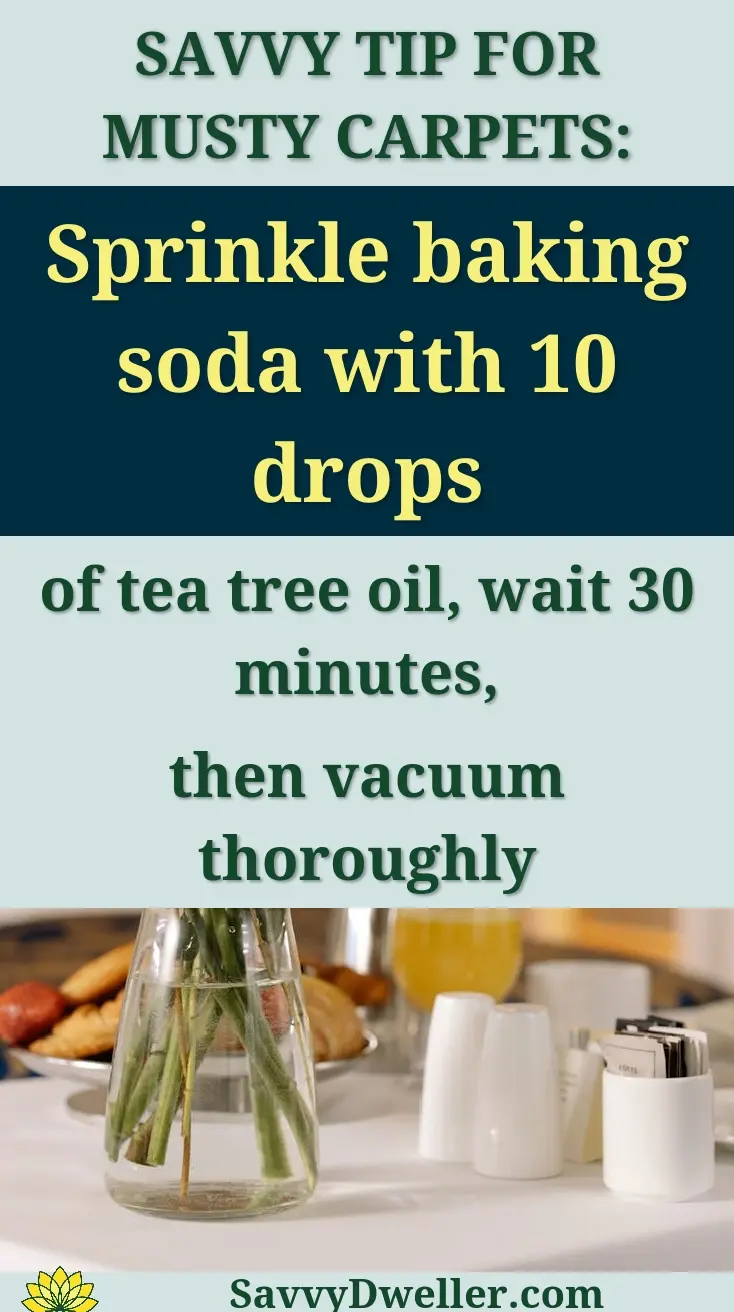
5 Habits to Keep Hard Water Stains From Coming Back
Prevention is always easier than removal when it comes to hard water stains. These simple habits reduce mineral buildup by up to 80% compared to reactive cleaning approaches. To truly tackle hard water stains, knowing how to effectively remove them is just as important as preventing them. A definitive guide on erasing hard water stains can provide practical tips and techniques for a spotless finish.
Daily Wipe-down Routine
Removing water droplets before they evaporate prevents mineral deposits from forming in the first place. This simple step takes less than a minute but saves hours of scrubbing later.
Keep a microfiber cloth in your bathroom and wipe fixtures dry after each use. Focus on areas where water tends to pool, like faucet bases and shower head connections.
This habit is particularly important in households with very hard water. The small daily investment prevents the thick, stubborn buildup that requires aggressive cleaning methods.
Weekly Deep Clean Schedule
Regular cleaning prevents mineral deposits from hardening into difficult-to-remove layers. Weekly attention keeps your fixtures looking new with minimal effort.
Set aside 10 minutes each week to clean all bathroom fixtures with a mild vinegar solution. This prevents the need for harsh chemicals or extended soaking sessions.
Consistent weekly cleaning also helps you spot potential problems early, like developing leaks or worn seals that contribute to excessive mineral buildup.
Water Softener Installation
Water softeners remove minerals before they reach your fixtures, eliminating hard water stains at the source. This investment pays for itself through reduced cleaning time and extended fixture life.
Whole-house water softeners can reduce mineral content by 95% or more. Even basic ion-exchange systems make a dramatic difference in staining rates.
Consider point-of-use softeners for individual fixtures if whole-house systems aren’t feasible. These compact units provide similar benefits for specific problem areas.
Regular Descaling Maintenance
Monthly descaling treatments keep internal fixture components free of mineral buildup. This maintenance prevents reduced water flow and premature component failure.
Remove and soak aerators and shower heads in vinegar solution monthly to maintain optimal performance. This simple step prevents the internal clogging that leads to irregular spray patterns.
Internal mineral buildup can cause fixtures to fail prematurely, requiring expensive replacements. Regular descaling extends fixture life significantly while maintaining proper function.
Protective Coating Applications
Specialized protective coatings create a barrier between minerals and fixture surfaces. These products make future cleaning easier while protecting finish integrity.
Rain-X and similar water-repelling products work excellently on shower doors and chrome fixtures. Reapply every 3-6 months for continued protection.
Car wax also provides effective protection for polished fixtures. The hydrophobic surface encourages water to bead and roll off rather than evaporating in place.
Frequently Asked Questions
Can Hard Water Stains Damage My Plumbing System Over Time?
Yes, if left unchecked, hard water stains can signal mineral buildup that may lead to plumbing issues. The scale accumulation inside pipes can reduce water flow and pressure, potentially causing clogs or damage to water heaters and appliances. Regularly descaling your fixtures and considering whole-house water treatment can help prevent these problems.
What is the Most Budget-friendly Method for Removing Hard Water Stains?
The white vinegar soak method is highly cost-effective, as vinegar is cheap and often already in your pantry. Combining it with a plastic bag and rubber band for a targeted soak minimizes waste and expense. For even lower cost, use baking soda or lemon juice, which are natural and effective for mild stains. You can learn more about using baking soda and vinegar for cleaning in our ultimate guide to cleaning with baking soda and vinegar.
How Can I Determine if My Home Has Hard Water?
You can use an affordable home water testing kit, available online or at hardware stores, to measure mineral content in grains per gallon (GPG). Look for results above 3.5 GPG, which indicates hard water. Alternatively, observe signs like difficulty lathering soap or white residue on fixtures, and check your local water utility’s annual report for hardness data.
Are There Any Situations Where I Should Avoid DIY Methods and Call a Professional?
Yes, seek professional help for severe scale buildup that blocks water flow, or if you have expensive, antique, or warranty-covered fixtures. Professionals have specialized tools and expertise to avoid damage, and they can assess if corrosion or plumbing issues require more than surface cleaning.
What Should I Do if a Cleaning Method Doesn’t Work on Stubborn Stains?
For tough stains, try alternating methods-like a vinegar soak followed by a baking soda scrub-or use a commercial descaler like CLR with extended contact time. Always test on a small, hidden area first to prevent damage. If stains persist, the fixture may need replacement due to irreversible etching or corrosion.
Final Words
Those stubborn hard water stains don’t stand a chance when you have the right approach. Whether you choose the gentle vinegar soak or the powerful commercial descaling method, consistency is your best friend in this battle against mineral buildup. Start with the mildest option first, and remember that patience during the soaking process always beats aggressive scrubbing.
Your fixtures will thank you for the gentle yet effective care, and your bathroom will sparkle like new again. The key is finding the method that works best for your specific fixture type and water hardness level. Don’t get discouraged if the first attempt doesn’t remove everything – sometimes the toughest stains need a second round of treatment.
Ready to transform your bathroom from dull to dazzling? Pick your preferred method from our proven techniques and get started today. For more expert home solutions and cleaning hacks that actually work, check out Savvy Dwelling for reliable advice you can trust in your daily home care routine.
Also See: The Ultimate Guide to Cleaning Dirty Tile Grout

